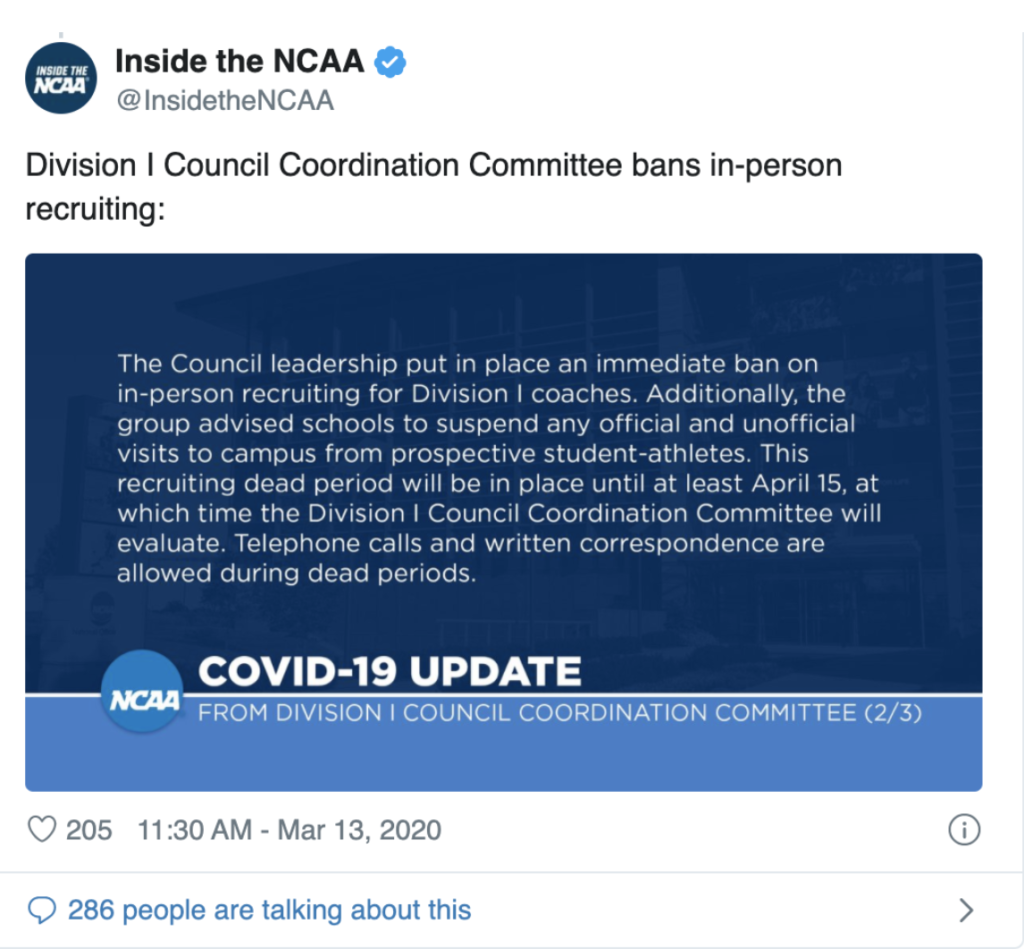Within 24 hours after the coronavirus was declared a global pandemic, the National Collegiate Athletic Association (NCAA) canceled remaining championships and seasons for every spring sport under the organization.
While the eligibility of student athletes’ seasons has been granted an additional season, a frenzy regarding the status of potential recruits has also begun to occur.
The NCAA has announced that there will be a recruiting “dead period” until May, where college coaches are not allowed to have face-to-face contact with prospective athletes or attend any games or tournaments. Meanwhile, coaches can still contact players via email and telephone calls.
Because the dead period allows restricted contact between coaches and players, it is crucial that players take full advantage of available resources to capture colleges’ attention. But these resources are not intuitive, and many players need guidance in order to best market themselves.
From what I’ve seen and the research I’ve done, most sports clubs are not doing enough to guide players through the demanding journey of getting recruited during the dead period. These organizations should create concrete plans for players so that when the dead period is lifted, they are already in a strong position to commit to a school.
Junior Neeya Devanagondi, who swims competitively for DACA, acknowledges the pressure she feels with her recruitment looming in the unknown future. With the individual work she’s doing to contact college coaches, she hopes that her club will be proactive in helping her with getting commited.
“It’s definitely stressful because the future is really uncertain and it isn’t possible to go on recruitment trips anymore,” Devanagondi said. “I’m hoping I’ll be able to figure out which schools are a right fit with my club coaches’ guidance.”
An example of guidance from clubs and coaches is educating players on how to present their resumes to colleges in a way that showcases both their athletic and academic achievements. Resumes are an extremely effective way to integrate a variety of information into a concise and organized platform, but not many students have experience putting them together.
Clubs could provide a template for players to use that includes different categories such as basic player information (name, graduating class, height, weight), in-depth athletic history (past clubs, positions, tournaments attended), academic achievements (honors, APs, prestigious academic awards) and extracurriculars (clubs, volunteering, etc.).
Along with resumes, clubs could also teach players how to not only create highlight videos, but also to look for clips that demonstrate skills college coaches want to see. While players would automatically only search for clips that include their MVP-worthy moments, most wouldn’t know that coaches also want to see plays where they assist a teammate or tenaciously recover from a mistake.
After players synthesize the resources they plan to send to coaches, they need to form a list of target schools. By analyzing both athletic and academic proficiency with club supervisors, players can compile a list of schools that are within their reach both inside and outside the classroom.
“Something I would find really helpful is if my club coaches found time to communicate with me on which schools they think I should target,” Devanagondi said. “Because they know a lot of college coaches personally, their input would mean a lot.”
From there, club coaches could help with the recruitment process by reaching out to those colleges and seeing if the interest is mutual between the college coaches and the potential recruit.
While all of these measures prepare athletes for recruitment after games and tournaments resume, clubs also need to encourage players to stay on top of their sport during the time off.
Coaches should create daily workout plans and technical drills that players can do in a limited space. If they give players spreadsheets to log their daily exercise and training, both the athletes and coaches can supervise their progress.
For example, Devanagondi’s coaches expect players to do individual ab work, jump roping, and running to keep up endurance and fitness. The team also does team yoga weekly over Zoom.
What makes this process more difficult is that some sports and clubs ban coaches from directly sending workouts to players. If a player were to injure themselves in an assigned exercise, the clubs could be held liable and sued under the Safe Sport Act.
In these rare cases, it is up to the player to implement what they have learned in team practices and try to manipulate these drills to be done individually.
The “dead period” for college recruiting does not mean that athletes don’t have an opportunity to create connections with coaches and move forward in their recruiting process.
Prospective recruits simply need guidance from their clubs to best prepare them for getting committed in the future. Many athletes work for their entire lives to play on the collegiate level, and clubs should strive to see their players reach that goal.
























